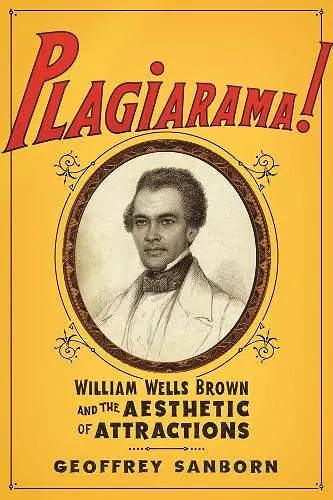Plagiarama!
William Wells Brown and the Aesthetic of Attractions
Format:Hardback
Publisher:Columbia University Press
Published:18th Mar '16
Currently unavailable, and unfortunately no date known when it will be back

In this study of William Wells Brown, the author of the first known novel by an African American and an extensive plagiarist, Geoffrey Sanborn offers a novel reading of Brown's plagiarism. He argues that the act was a means of capitalizing on the energies of mass-cultural entertainments. Sanborn's analysis of pastiche and plagiarism adds new depth to the study of nineteenth-century cultural history and African American literature, suggesting modes of African American writing that extend beyond narratives of necessity and purpose.
William Wells Brown (1814–1884) was a vocal abolitionist, a frequent antagonist of Frederick Douglass, and the author of Clotel, the first known novel by an African American. He was also an extensive plagiarist. In Plagiarama!, Geoffrey Sanborn offers a novel reading of Brown’s work and legacy.William Wells Brown (1814-1884) was a vocal abolitionist, a frequent antagonist of Frederick Douglass, and the author of Clotel, the first known novel by an African American. He was also an extensive plagiarist, copying at least 87,000 words from close to 300 texts. In this critical study of Brown's work and legacy, Geoffrey Sanborn offers a novel reading of the writer's plagiarism, arguing the act was a means of capitalizing on the energies of mass-cultural entertainments popularized by showmen such as P. T. Barnum. By creating the textual equivalent of a variety show, Brown animated antislavery discourse and evoked the prospect of a pleasurably integrated world. Brown's key dramatic protagonists were the "spirit of capitalization"-the unscrupulous double of Max Weber's spirit of capitalism-and the "beautiful slave girl," a light-skinned African American woman on the verge of sale and rape. Brown's unsettling portrayal of these figures unfolded within a riotous patchwork of second-hand texts, upset convention, and provoked the imagination. Could a slippery upstart lay the groundwork for a genuinely interracial society? Could the fetishized image of a not-yet-sold woman hold open the possibility of other destinies? Sanborn's analysis of pastiche and plagiarism adds new depth to the study of nineteenth-century culture and the history of African American literature, suggesting modes of African American writing that extend beyond narratives of necessity and purpose, characterized by the works of Frederick Douglass and others.
This deftly researched and compellingly written account reminds the reader of [William Wells] Brown's power as a writer, and resituates him as both an important antiracist thinker in the Civil War era and a powerful writer who is part of the narrative of 19th-century American culture... Recommended. Choice Should stimulate much-needed discussion on plagiarism and originality, authorship and ethics. Times Literary Supplement A dynamic, original discussion about plagiarism and the self-multiplying discursive aesthetics of William Wells Brown. The ALH Online Review Series X
ISBN: 9780231174428
Dimensions: unknown
Weight: unknown
224 pages